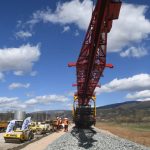 Serbian President Aleksandar Vučić, the EU Ambassador to Serbia Emanuele Giofre, ministers in charge and repesentatives of EIB Global, have officially launched the reconstruction and modernisation work of Pirot – Sukovo section on the line between Niš and Dimitrovgrad which ensures the Serbia – Bulgaria rail connection.
Serbian President Aleksandar Vučić, the EU Ambassador to Serbia Emanuele Giofre, ministers in charge and repesentatives of EIB Global, have officially launched the reconstruction and modernisation work of Pirot – Sukovo section on the line between Niš and Dimitrovgrad which ensures the Serbia – Bulgaria rail connection.
“This project is of crucial importance, not only for the Pirot district, but also for Belgrade and for the whole of Serbia. In a structural sense, it means massive changes for our country. This is a great indicator of everything we are doing in the southeast of Serbia,” the President said.
The overall modernisation of the 104 km long Niš – Dimitrovgrad railway line includes the reconstruction and modernisation of the existing, non-electrified single-track railway line from Sićevo to Dimitrovgrad. It also covers the construction of the northern rail bypass around the City of Niš as well as the electrification and signalling of both the existing railway line from Sićevo to Dimitrovgrad and the Niš bypass. The project will not only improve the railway traffic from the City of Niš to the border with Bulgaria, but due to the newly introduced bypass take the trains out of the city centre of Niš and thus contribute to the facilitation of traffic in the urban area of the City of Niš. As part of the EU Economic and Investment Plan, the overall modernisation of the entire railway line will result in shorter journey times and improved safety and regional connectivity, while enabling a gradual shift to more environmentally friendly transport options.
Speaking about the Serbia – Bulgaria rail modernisation, Aleksandar Vučić said that “I am grateful to everyone who carried out this project, and especially to Ambassador Giofre and the European Commission, who gave us an extremely large amount of funding, so that Serbia would develop and be a better place to live. We need to work constantly, to build new roads, new railways, in order to have a strong country. Our goal, need and desire is to be a healthy economy, to move forward, in order to be proud of such big projects,” Aleksandar Vučić said.
The EU financial package for this project consists of over EUR 108 million in grants delivered through the Western Balkans Investment Framework (WBIF) and a EUR 134 million loan from the EIB. The project will also benefit from a EUR 3.7 million technical assistance grant for preparation, and a EUR 1.5 million grant under the EU Instrument for Pre-accession Assistance (IPA) to design and build the bypass around the city of Niš. The EIB JASPERS advisory programme, co-financed by the European Commission, provided technical assistance for the project preparation, with a view to securing blended financing through grants and loans.
The modernisation and reconstruction of Niš – Dimitrovgrad railway will be completed by the end of 2027 and will provide a 130-minute journey from Belgrade to Niš, and three hours from the capital to Pirot and will significantly reduce travel time towards Istanbul.
Improved infrastructure will enable an increase of speeds from a current average of 50 km/h to up to 120 km/h and positively impact travelling patterns by increasing the annual number of passengers from around 170.000 to 550.000, as well as total freight transport from 3.2 to around 6.2 million tonnes a year.
This railway line is part of the Pan-European Railway Corridor X (Xc branch) through Serbia and is currently the only part of the corridor still non-electrified, with traffic relying on diesel traction. Its electrification will provide a faster, greener and safer railway connection within the country and further on into Bulgaria. The line is part of the corridor connecting Central Europe to Bulgaria and Turkey through Croatia and Serbia.
The rail section between Niš and Dimitrovgrad is an important bottleneck on Serbia – Bulgaria rail and along the corridor X, being the only part of the entire corridor that is not electrified and having a weight limits of category D3 (22,5 tonns for axle load). The Bulgarian side of the corridor is electrified with the same system adopted in Serbia and in Croatia (25 kV AC 50 KHz) and has a weight limit of category D4 (permissible axle load of 22,5 tonnes and permissible load per linear metre of 8 tonnes/m). This is the reason why the station of Dimitrovgrad is electrified, being reached by the Bulgarian network.
The existing line has a total length of about 104 km from Niš to the border with Bulgaria and Dimitrovgrad is situated at a distance of 97 km from Niš, and such station is working as operational border between the Serbian and Bulgarian rail systems.
Share on:









